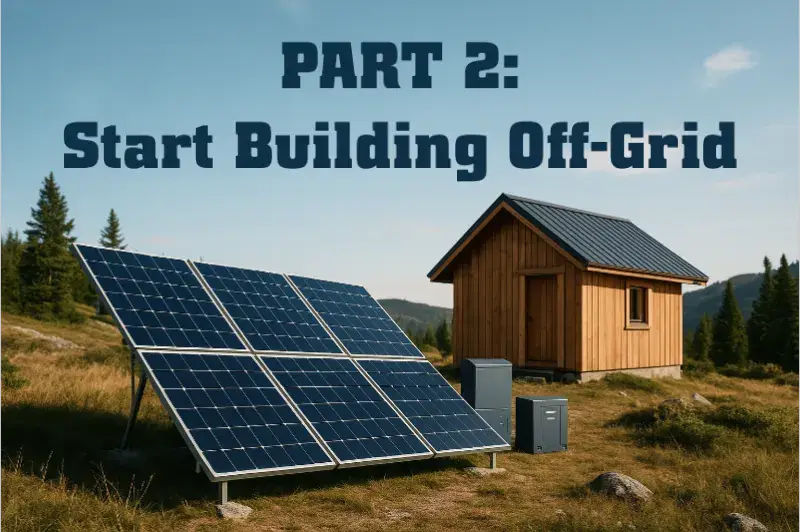
Part 2: Start Building Off-Grid: Planning, Products & Practical Advice for Your Power System
So you’ve decided to explore off-grid living—great choice and the perfect time to start building off-grid.
But where do you start?
Setting up an off-grid system is like designing your own micro-utility company. You’re not just choosing gadgets; you’re building a complete energy ecosystem that fits your lifestyle or business goals.

Below, we’ll walk you through how to think about that system—from choosing the right components to avoiding common mistakes.
🔍Step 1: Define Your Energy Needs
Before buying anything, ask the big question:
“How much energy do I actually use—and how much do I want to produce?”
For homes, this means:
- Lighting
- Heating/cooling
- Appliances (fridge, washer, etc.)
- Device charging
- Internet and entertainment systems
For businesses, it could include:
- Heavy machinery
- Commercial refrigeration
- IT infrastructure
- Security systems
- 24/7 uptime requirements
Pro Tip: Track Energy Use to Build Your Off-Grid Power System Right
⚡ Step 2: Choose Your Energy Source(s)
☀️ Solar Power (most popular)
Clean, silent, and increasingly affordable. Works best when paired with high-efficiency Fronius solar inverters and Victron MPPT charge controllers.
💨 Wind Power
Ideal in exposed rural or coastal locations. Best as a complement to solar.
🔋 Backup Generators
For businesses or homes with critical loads, Himoinsa diesel generators or EcoFlow Smart Generators offer reliable backup during long periods of low generation.
🔋 Step 3: Battery Storage — The Heart of Your System
To start building off-grid, reliable batteries are essential. The type you choose impacts lifespan, performance, maintenance, and cost.
Recommended Solutions:
- Cegasa Lithium Batteries – Engineered for industrial-scale use, extreme reliability, and high power density
- Victron Energy Smart Batteries – Modular, high-performance, ideal for domestic and mobile off-grid systems
- EcoFlow Portable Units – All-in-one batteries with built-in inverters and smart monitoring
🔄 Step 4: Inverters & System Integration
An inverter turns your stored energy (DC) into usable electricity (AC).
For Homes:
- Victron MultiPlus or Quattro: Advanced hybrid inverters that integrate solar, battery, and generator seamlessly
- Fronius GEN24: Excellent for hybrid grid/off-grid systems with solar prioritisation
For Businesses:
- Industrial-grade Victron Quattro systems with programmable logic
- Fronius commercial inverters for large-scale solar production and real-time monitoring
🔌Step 5: Wiring, Monitoring & Safety
No matter how powerful your gear is, a poorly installed system can cause damage—or worse, risk safety.
That’s why at Akiva Tech, we recommend:
- Victron Cerbo GX or Color Control – Central brains of the operation for remote monitoring
- Proper fuses, breakers, and isolators
- Certified installers for final connection and testing
Akiva Tech can help you start building off-grid with expert equipment recommendations, system design, and setup advice—whether you’re doing a DIY install or hiring a pro.
📋 Common Mistakes When You Start Building Off-Grid
- Under-sizing your system
People often underestimate their power usage. It’s better to slightly oversize than constantly run out of juice. - Skipping a backup plan
Even the best solar array can go dark for a week. Always have a generator or alternative source. - Cheap gear = costly problems
Off-grid gear lives a hard life. Cut-rate components often fail when you need them most. Stick to trusted brands like Victron, Fronius, Cegasa, EcoFlow, and Himoinsa. - No room to scale
Start modular. A system that can grow over time (like Victron modular systems) is more adaptable and future-proof.
🔧 Real-World Scenarios (And How to Build for Them)
🏠 Off-Grid Home in Rural UK
- Power source: 6 kW solar array
- Inverter: Victron MultiPlus 48V
- Storage: 15 kWh Cegasa battery bank
- Backup: Himoinsa silent diesel generator
- Monitoring: Victron Cerbo GX
🚐 Van Conversion for a Digital Nomad
- Power source: 600W solar on the roof
- Inverter: EcoFlow Delta Pro
- Battery: Built-in lithium with expansion pack
- Extras: Portable EcoFlow panels for remote work anywhere
🏭 Commercial Farm Operation
- Power source: 30 kW solar ground array
- Inverter: Fronius Symo 3-phase
- Storage: 40 kWh Cegasa lithium bank
- Backup: Himoinsa hybrid generator system with auto start
- Controls: Victron Cerbo GX + Fronius Solar.web integration
Off-Grid FAQs
❓ What’s the best battery for off-grid living?
Start building off-grid with Akiva Tech’s expert support—from equipment recommendations to system design and setup advice, whether you're doing it yourself or hiring a pro.
❓ Can I live off-grid in the UK legally?
Yes—but you must comply with building regulations and planning permissions. Many people successfully live off-grid in Scotland, Wales, and rural England.
❓ How much does it cost to go off-grid?
Costs range from £5,000 for a minimal van setup to over £50,000 for a full home system. Akiva Tech can advise on scalable systems that suit your budget.
❓ What’s the difference between EcoFlow and Victron?
EcoFlow is plug-and-play, great for mobility and simplicity. Victron is modular and technical—ideal for long-term, complex installations.
❓ Are generators necessary for off-grid?
Not always, but they’re highly recommended as a fallback, especially in the UK’s unpredictable climate. Brands like Himoinsa offer robust diesel solutions.
📣 Stay Curious, Stay Powered
Whether you’re sketching your dream off-grid cabin or future-proofing a commercial site, we’re here to help you power that vision into reality.
👉 Check out our blog Part 1 for ongoing advice, technical guides, and real-world success stories that make off-grid living achievable—on your terms.
Start Building Off-Grid! Contact Akiva Tech for expert guidance, tailored product recommendations, and personalized support.
